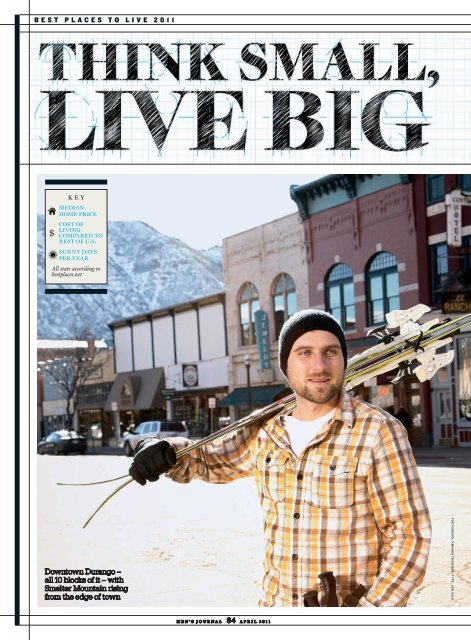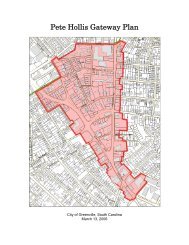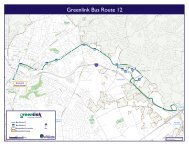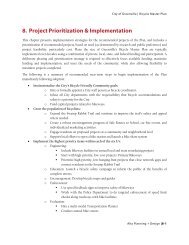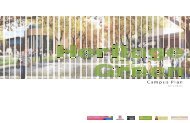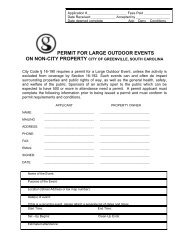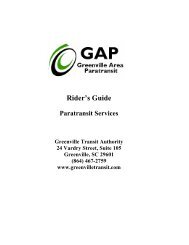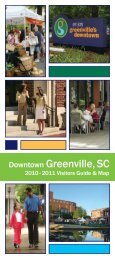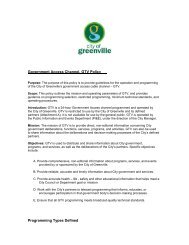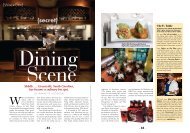Men's Journal - Upstate Forever
Men's Journal - Upstate Forever
Men's Journal - Upstate Forever
You also want an ePaper? Increase the reach of your titles
YUMPU automatically turns print PDFs into web optimized ePapers that Google loves.
BEST PLACES TO LIVE 2011<br />
$<br />
key<br />
median<br />
home price<br />
cost of<br />
living<br />
compared to<br />
rest of u.s.<br />
sunny days<br />
per year<br />
All stats according to<br />
bestplaces.net<br />
Downtown Durango —<br />
all 10 blocks of it — with<br />
Smelter Mountain rising<br />
from the edge of town<br />
PHOTOGRAPH: AMANDA FRIEDMAN. TYPE: JON VALK<br />
M E N ’ S J O U R N A L<br />
84 A P R I L 2011
These 18 towns are perfecting the art<br />
of living well — places where conservation<br />
is more important than development,<br />
bike makers and breweries and<br />
farmers markets thrive, and Whole<br />
Foods is considered a big-box store.<br />
by robert earle howells<br />
PUT YOUR OUTDOOR LIFE FIRST<br />
DURANGO, CO<br />
MIX WITH ARTISTS<br />
AND ATHLETES<br />
SARASOTA, FL<br />
“It’s Florida for people who hate Florida,”<br />
says a Sarasota booster. In other words, it’s<br />
the rare subtropical city that has decided<br />
to revoke its anything-goes attitude toward<br />
expansion, where being active means more<br />
than steering a golf cart. Voters approved<br />
acquisition of 35,000 acres of open land to<br />
bring the county total of acres off-limits to<br />
development to 80,000. Sarasota is home<br />
to the Ultimate Frisbee national championships;<br />
the rowing scene is huge; and people<br />
bike to work on a growing network of trails.<br />
And while prim arts like opera have always<br />
flourished here, more avant-garde fare is on<br />
the upswing. (Electronica grabs the stage<br />
during April’s Vinyl Music Festival.) The<br />
Ringling College of Art and Design cranks<br />
out video-game and other digital designers,<br />
and HuB is a local epicenter for networking<br />
artists, media, and software companies that<br />
rent space there.<br />
PHOTOGRAPH: BRANDON BURNETT/ALAMY. ILLUSTRATIONS THROUGHOUT: JOE MCKENDRY<br />
In its taste for fleece<br />
$318,480<br />
and proximity to aweinspiring<br />
mountains,<br />
$ 24% higher<br />
Durango often gets<br />
266 days<br />
compared to Boulder<br />
20 years ago. But with<br />
its isolation, modest size and population<br />
(16,000), and a down-home, just-folks genuineness,<br />
Durango clearly doesn’t aspire to<br />
Boulder’s growth, and it will never be a bedroom<br />
community for any metropolis.<br />
Tucked down in the southwest corner of<br />
Colorado, where the San Juan Mountains<br />
meet the arid Colorado Plateau, Durango<br />
has plenty of trademark Rocky Mountain<br />
beauty. But what distinguishes it from places<br />
like Boulder — or dream towns like Aspen<br />
and Vail — is how protecting its way of life<br />
and defining qualities is built into the town<br />
charter as well as its collective zeitgeist.<br />
Residents voted years ago to tax themselves<br />
to raise funds for parks, open space, and trails,<br />
all of which it has in crazy proportions relative<br />
to its size — 1,575 protected acres in town<br />
alone. Volunteers fervently maintain local<br />
trails through a nonprofit called Trails 2000,<br />
which boasts 2,000 members — that’s 12<br />
percent of the total population.<br />
The high-desert city, cleaved by the<br />
Animas River and perched 6,500 feet high<br />
MODEL CITIZEN<br />
at the stoop of the San Juans, has just enough<br />
oil and gas, ranching, and clean tech to support<br />
a handful of coffeehouses doing fairtrade<br />
brews, four microbreweries (seriously<br />
— it’s the water), and fine community arts<br />
and theater programs in an Old West downtown.<br />
The presence of four-year Fort Lewis<br />
College lends an additional cultural boost,<br />
but Durango is also decidedly laid-back, the<br />
kind of town where a shopkeeper is likely to<br />
lock up early and post a G O N E SKIING sign<br />
when fresh powder falls at Purgatory, just 24<br />
miles away.<br />
High-paying gigs are scarce, but plenty<br />
of locals are happy to work two jobs for the<br />
right to live in a place so blessed by geography<br />
and sunshine. A mile south of downtown,<br />
the RiverGate complex has lofts overlooking<br />
the Animas, with views of the La Plata Mountains<br />
and hop-on access to the town’s main<br />
bike path. Cars are left parked for weeks at<br />
a time as kayaking, fishing, hiking, and<br />
mountain biking are right out the door, as<br />
are millions of acres of Forest Service and<br />
BLM land. A Durango ritual that speaks<br />
volumes is visible on any summer Friday,<br />
about 5 PM — it’s the Animas River clogged<br />
with tubers nursing beers and hailing one<br />
another as they drift through town — happy<br />
hour in a happy place.<br />
JEREMY DAKAN Manager, Pine Needle Mountaineering<br />
Colorado-born Jeremy Dakan did stints in such hallowed<br />
outdoor havens as Bend, Oregon; Park City, Utah; and Salt<br />
Lake City before coming to Durango four years ago and<br />
taking a job at outdoor shop Pine Needle. And he plans<br />
to stay: He’s lining up loans to buy the shop when its<br />
current owners retire. “If it’s not snowing, we’re out riding<br />
our bikes. I can ride to work, ride to my favorite fishing<br />
spot, ride home at lunch, and I can run my dog by the<br />
river,” he says. “It’s a real community, not like a lot of resort<br />
towns. People live here because they want to be here —<br />
there’s a lot of overquali fied waitstaff in Durango. I’m not<br />
going to get rich, but I’ll make a decent enough living.”<br />
LIVE IN “SILICON<br />
PRAIRIE”<br />
DES MOINES<br />
Once synonymous with boring, Des Moines<br />
has acquired a bit of urban-hip sheen — a<br />
new sculpture park with $40 million in<br />
art pieces (including a De Kooning), new<br />
top-tier restaurants, and offices linked by<br />
skywalks in a once-somnolent downtown.<br />
It’s also the flagship of an area of the<br />
country now known as Silicon Prairie. Tech,<br />
particularly agriculture biotechnology, is<br />
creating jobs and drawing younger workers,<br />
and Dell has a strong presence here too.<br />
Unemployment is low, and the cost of living<br />
is 10 percent under the national average,<br />
while home prices are a whopping 12 percent<br />
lower than the norm.<br />
START SOMETHING<br />
MEMPHIS<br />
Lots of cities are doing what they can to<br />
encourage start-ups, but in Memphis it<br />
seems the whole city is starting something<br />
— be it a tech company or a garage band<br />
— and everybody wants to help one another.<br />
Innovative entrepreneur backers like<br />
EmergeMemphis steer fledgling tech firms<br />
toward seed money, while LaunchMemphis<br />
runs start-up boot camps, often led by<br />
members of Memphis’s many-tentacled music<br />
community. So it’s no surprise that the<br />
Memphis Symphony might play Bach at the<br />
Cannon Center one night and the next take<br />
the stage at a club with boho rocker Harlan<br />
T. Bobo, thanks to the orchestra’s “music<br />
without boundaries” program. Memphis<br />
also has a half-dozen farmers markets, and<br />
Project Green Fork certifies restaurants for<br />
going green and buying local.<br />
A P R I L 2 0 1 1<br />
85 M E N ’ S J O U R N A L
FORGET THE<br />
RECESSION<br />
FARGO, ND<br />
Fargo is a city on the rise in a state with low<br />
taxes (and going down), a budget surplus,<br />
and low unemployment (4 percent). It also<br />
has the biggest Microsoft campus outside<br />
Redmond, so we’re not just talking about<br />
assembling tractors. You’ll find clean air and<br />
even some nascent hipness (HoDo Lounge<br />
martini bar!) in a revitalized downtown full<br />
of historic but urbane brick buildings and<br />
North Dakota State students.<br />
FIND COMMUNITY<br />
NORTHAMPTON, MA<br />
Here’s the kind of place Northampton is:<br />
When 120 acres of nearby historic farmland<br />
came up for sale, locals said, “We want it.”<br />
The town of 29,000 formed a nonprofit,<br />
Grow Food Northampton, determined to<br />
raise money to buy the land and establish<br />
a community farm. They held forums,<br />
launched a Facebook page, and in less than<br />
a year had the $675,000 they needed.<br />
Now this town of Smith College professors,<br />
urban refugees, and tech workers is in the<br />
organic-food business. The farm will also<br />
provide plots to locals and produce to food<br />
banks and shelters.<br />
Minneapolis’s<br />
new six-mile bike<br />
thoroughfare<br />
LIVE IN A BIG CITY DESIGNED<br />
FOR GETTING OUTSIDE<br />
MINNEAPOLIS<br />
KEEP YOUR BRAIN<br />
IN SHAPE<br />
HUNTSVILLE, AL<br />
This city of 400,000 near the southern<br />
Appalachian foothills — where Monte<br />
Sano, with its 14 miles of hiking and biking<br />
trails, rises to 1,600 feet — is the home<br />
of the U.S. Space & Rocket Center and<br />
the NASA-affiliated Marshall Space Flight<br />
Center, which employs 2,500 scientists.<br />
The “Rocket City” also has minor-league<br />
baseball and hockey teams. You can nab a<br />
four-bedroom home for around $200,000<br />
and pay under a grand a year in taxes for it.<br />
RAISE AN ATHLETE<br />
FRISCO, TX<br />
One of the fastest-growing cities in the<br />
U.S. hit its stride via an ingenious formula:<br />
Build state-of-the-art sports venues to<br />
attract professional teams, then use the tax<br />
boon to create a fiscally healthy paradise<br />
for jocks. The result: a booming and<br />
hyper active community of soccer moms and<br />
baseball dads whose offspring are involved<br />
in countless athletic programs and have<br />
superb places to play. Frisco, 25 miles north<br />
of Dallas, soared from 33,000 to 110,000<br />
and has a median age of 32. Revenue from<br />
the minor-league ballpark, hockey arena,<br />
and MLS soccer stadium gets recycled to<br />
benefit parks, bike paths, public art, and a<br />
historic downtown.<br />
Minneapolis’s endemic<br />
$171,670 love affair with water<br />
$ 4% higher and woods — and<br />
playing in both — has<br />
198 days<br />
always driven city<br />
planning. Parklands,<br />
the Mississippi River, Minnehaha Falls, and<br />
a chain of 22 lakes have been part of the<br />
city’s fabric since its inception. Today, Minneapolis<br />
has so many parks that no resident<br />
is farther than six blocks from green space.<br />
And with everyone constantly running,<br />
skiing, biking, canoeing, or skating, it only<br />
made sense to link the parks with bike trails.<br />
Hence an ever-growing, 128-mile network of<br />
lanes and paths, including the city-spanning<br />
Midtown Greenway, has encouraged a remarkable<br />
(4.3%) rate of bicycle commuting. Add<br />
in warrens of single-track mountain-bike loops<br />
(e.g., Theodore Wirth Park, Fort Snelling State<br />
Park) that morph neatly into cross-country<br />
ski trails in winter, and there’s no doubt why<br />
Bicycling magazine last year named Minneapolis<br />
the country’s top bike city.<br />
MODEL CITIZEN<br />
But isn’t winter the gorilla in the room?<br />
“If you live here, you just get used to the fact<br />
that it’s cold and snowy for six months at a<br />
time,” says Stephen Regenold, a native who<br />
writes a syndicated outdoor column and has<br />
a website called Gear Junkie. “You put on<br />
some winter gear and snowshoes and trek<br />
into the woods at Three Rivers Park. Staring<br />
up at the stars, you might as well be 400<br />
miles north.”<br />
Minneapolis has acquired a bit of multicultural<br />
hipness in recent years, and its<br />
eclectic arts district with converted-warehouse<br />
galleries and ethnic eateries add tangible<br />
livability. Downtown and the adjacent<br />
northeast have revived those once-ghosttown<br />
districts with condos and artists lofts.<br />
By now, flourishes that might be considered<br />
trendy elsewhere are simply built into Minneapolis’s<br />
DNA — a huge organic, eat-local<br />
scene spurred by no fewer than 17 farmers<br />
markets. (The biggest one dates back to<br />
1937.) It’s a city that not only exercises daily<br />
but knows how to live well, too.<br />
JOSHUA KLAUCK Bike-shop and coffeehouse owner<br />
Nothing represents Minneapolis’s love of the outdoors<br />
and the artisanal more than Joshua Klauck’s Angry<br />
Catfish bike and coffee shop, housed in a converted<br />
hardware store “that was pretty much a shithole.”<br />
Klauck spruced it up with the help of a grant from his<br />
local neighborhood association and now sells the two<br />
things he loves most: top-notch organic brews and<br />
handmade bikes. “I’m inspired to sell bikes that inspire<br />
me.” Klauck, of course, rides to work every day, yearround,<br />
weather be damned.<br />
FROM TOP: MICAH TAYLOR; JASON WALLIS<br />
M E N ’ S J O U R N A L 86 A P R I L 2011
TAKE A<br />
CHANCE ON A<br />
CRAZY IDEA<br />
GRAND RAPIDS<br />
BEST PLACES TO LIVE 2011<br />
Few cities anywhere do<br />
$82,370<br />
more to support creativity<br />
than Michigan’s<br />
$ 20% lower<br />
second-largest metropolis.<br />
Entrepreneur Rick<br />
158 days<br />
DeVos, scion of an<br />
Amway founder, is the brains behind Momentum,<br />
which awards budding entrepreneurs<br />
$20,000 and a 12-week start-up boot<br />
camp, as well as ArtPrize, the world’s largest<br />
art competition, which shells out $450,000<br />
among 10 winning artists, who then install<br />
their work in approved venues. (A public<br />
vote determines who gets the dough.) Both<br />
befit a city whose roots and image are steeped<br />
in design consciousness, from early days as a<br />
furniture center to being the present-day<br />
home of Herman Miller, Steelcase, and the<br />
Kendall College of Art and Design.<br />
That energy spreads throughout the city:<br />
the highest number of eco-friendly LEEDcertified<br />
buildings per capita in the U.S., a<br />
college that awards degrees in sustainable<br />
business, an abundance of public art, and a<br />
district of galleries called Avenue for the Arts.<br />
The latter typifies the city’s walkable clusters<br />
— like Gaslight Village and East Hills — which<br />
in turn display the artisanal and culinary vibe<br />
of a town with 10 craft breweries and top<br />
restaurants helmed by grads of the local culinary<br />
institute.<br />
BECOME A LOCALIST<br />
PORTSMOUTH, NH<br />
Local hangout Portsmouth<br />
Brewery, in the<br />
heart of downtown<br />
FROM TOP: STACEY CRAMP; ADAM BIRD<br />
Kayakers take a lap<br />
around art-prize finalist<br />
Nessie on the Grand.<br />
The idyllic harbor town on New Hampshire’s 17-mile stretch of<br />
$268,780<br />
coast bears some of the better attributes of its neighbors — the<br />
$ 28% higher coastal beauty of Maine and the cultural vigor of Massachusetts<br />
— but Portsmouth is decidedly New Hampshire. That means no<br />
198 days<br />
income tax, no sales tax, and a fierce pride in localism, which is<br />
fostered through innovative programs designed to promote<br />
homegrown resources and talent and to protect the town’s heritage.<br />
A couple of decades ago, city planners decided to reel in would-be mall-goers by<br />
spiffing up the historic downtown — slowing down traffic, adding comfy spots to sit.<br />
Locals take an active role in city planning through a program called Portsmouth<br />
Listens, which helps guide the town’s master plan by way of small study groups held<br />
around town. Having won kudos from entities like the National Trust for Historic<br />
Preservation, local planners “understand that people don’t say, ‘Hey, let’s go to Portsmouth<br />
because it has a Banana Republic,’ ” says Tom Holbrook, whose independent<br />
RiverRun bookstore is among dozens of small businesses that benefit from the museumquality<br />
ambience of a walkable city core.<br />
That cultivated local flavor also attracts plenty of visitors (Portsmouth is an hour’s<br />
drive from Boston), who help support more than a dozen nearby theaters and more<br />
than a hundred eateries, in a town of only 21,000. Chefs join area growers and businesses<br />
in Seacoast Local, a major eat/shop-local campaign, and a huge farmers market<br />
continues right through the winter by retreating to a greenhouse. What is not so<br />
idyllic is the cost of housing, but the economy is doing well here and some bargains<br />
can be had. (Historic brick homes in the Atlantic Heights neighborhood, a quick bike<br />
ride to downtown, are in the mid-$200,000 range.) Today the nearby Navy shipyard<br />
employs 5,000 civilians, and the town is a hub of high-tech, biotech, and design firms.<br />
A group called eCoast works to connect start-ups with angel investors, and its members<br />
stage a monthly eBrew to network over hand-pulled pints. After all, brewing too<br />
is part of the fabric of Portsmouth history.<br />
A P R I L 2011<br />
87 M E N ’ S J O U R N A L
BEST PLACES TO LIVE 2011<br />
BE A PART OF THE CITY<br />
OF THE FUTURE<br />
NEW ORLEANS<br />
New Orleans isn’t<br />
$124,440<br />
just rebuilding; it’s<br />
$ 5% lower reinventing itself<br />
with an entrepreneurial<br />
energy and<br />
216 days<br />
urban activism that<br />
have transformed the city into an exciting<br />
laboratory for urban design. “A lot of us<br />
were forced to burn our boats after Katrina<br />
The newly thriving<br />
Warehouse District<br />
— to ask, ‘Do I really want to be here?’ says<br />
Robbie Vitrano, whose healthy-pizza chain<br />
Naked Pizza opened in a building that was<br />
once under six feet of water. “But if you love<br />
the city, the question became, ‘How do I best<br />
use my footprint?’ ”<br />
New Orleans’s template for the future has<br />
basically been drawn up by devoted locals,<br />
who favor neighborhood-driven development<br />
and an influx of entrepreneurs from all over<br />
the country, and who see this as one of their<br />
generation’s biggest challenges. Ground zero<br />
for the movement is the once-quiet Warehouse<br />
District, an elegant yet funky mix of<br />
repurposed traditional and industrial buildings<br />
near the river. These days it’s a buzzing<br />
spot to live, work, and play. “The neighborhood<br />
has become a magnet for people from<br />
all over who want to help rebuild one of<br />
America’s great cities,” says Tim Williamson,<br />
cofounder of the Idea Village, which links<br />
local start-ups to corporate brainpower and<br />
seed money. “Now they’re connected to the<br />
soul of New Orleans.”<br />
That spirit is in obvious contrast to the<br />
clumsy efforts of post-storm FEMA, which is<br />
why a scarred New Orleans has spurned a<br />
top-down makeover in favor of more focused<br />
development. Case in point: the architecturally<br />
striking, reasonably priced (well under<br />
$200,000), very green, and seemingly stormproof<br />
homes built by programs like Brad Pitt’s<br />
Make It Right in the Lower Ninth Ward and<br />
architect William Monaghan’s Build Now.<br />
While many of the hardest-hit neighborhoods<br />
won’t truly bounce back for years, the showcase<br />
homes inject grace notes of optimism<br />
and a new way of thinking.<br />
Traditional neighborhoods like Faubourg<br />
St. John, which was spared the worst of the<br />
flooding, are emerging as havens for creative<br />
types as well. Citywide, the qualities that<br />
have always earned New Orleans such deep<br />
affection are back and better than ever. Traditional<br />
music is thriving, and the city has<br />
more restaurants (about 1,000) than prior<br />
to the storm. New bars seem to open every<br />
month, like Robert LeBlanc’s gastro-pub<br />
Capdeville and Cole Newton’s midcity dive,<br />
Twelve Mile Limit. Meanwhile, enterprises<br />
ranging from Mr. Chill’s barbershop to Renee<br />
Brown’s Bayou Brew Wellness Tea have<br />
used seed money to rise up and prosper. Five<br />
years ago, the city’s population stood at less<br />
than half its pre-Katrina total (455,000).<br />
Today, it’s more than 70 percent of the<br />
prestorm total — and growing.<br />
Evening picnickers<br />
at the Britt<br />
Music Festival<br />
ESCAPE THE CROWDS<br />
JACKSONVILLE, OR<br />
Jacksonville’s 19thcentury,<br />
gold rush–era<br />
$292,940<br />
$ 25% higher downtown is on the<br />
National Register of<br />
199 days<br />
Historic Places, but the<br />
town’s old-fashioned<br />
look, feel, and values are more a product of<br />
ethos than edict. The core is protected, and<br />
the local Woodlands Association has preserved<br />
woods and trails all around it. But the<br />
Craftsman and Queen Anne cottages are tidy<br />
from pride, not law. There’s no proscription<br />
against golden arches or chain stores, but “if<br />
someone tried to open one, there’d be a<br />
bloodbath,” says a local merchant. The town<br />
of 2,700 may have only one gas station and<br />
no neon signs, but it’s not totally cut off:<br />
Nearby are Crater Lake and Oregon’s latest<br />
wine region, Applegate Valley, which is producing<br />
some of the country’s best pinot noir.<br />
Jacksonville is largely a town of shopkeepers<br />
and telecommuters; if that’s not you, look a<br />
few miles down the road to Medford or touristy<br />
Ashland for work.<br />
FROM TOP: RANDY HARRIS; TORSTEN KJELLSTRAND/THE OREGONIAN<br />
M E N ’ S J O U R N A L 88 A P R I L 2011
DO THE CALI COAST RIGHT<br />
SAN LUIS OBISPO, CA<br />
San Luis Obispo is a city very clear about what it is not — Los Angeles or<br />
$478,960 San Francisco, although it lies exactly halfway between the two — and<br />
$ 64% higher what it is: a place favored by sublime geography, whose endurance is assured<br />
by smart city planning. The old Spanish mission town is cradled<br />
287 days<br />
among hills just far enough inland to be out of the Central Coast fog belt,<br />
but close enough to the ocean for a prebreakfast surf session. It’s not too<br />
big or too small (population 45,000), too hot or too cold (85 degrees is a hot day; 65 degrees is<br />
chilly), too busy or too sleepy. Its only extreme might be beauty: tree-lined streets leading to the<br />
1794 mission, a pedestrian-only heart of town, oak-studded hills. Just outside city limits are an<br />
emerging wine region and the kind of rolling country lanes that roadies dream about.<br />
SLO, as it’s known to locals, got some major ink last year in a book called Thrive by Dan<br />
Buettner. Citing “stratospheric levels of emotional well-being” in a Gallup-Healthways poll,<br />
he profiled the town as one of the happiest in the U.S. That’s by design, not happenstance.<br />
Ordinances keep development from creeping up the city’s signature hillsides. SLO banned<br />
fast-food drive-throughs years ago, and it was the first city in the country to nix indoor smoking<br />
in public places. (It recently adopted an outdoor ban that is among the nation’s toughest:<br />
no smoking on sidewalks, in parks, or in the downtown Mission Plaza.) Mom-and-pop and<br />
Starbucks live together in peace, and no one dares to suggest cleaning up Bubble Gum Alley,<br />
where a million or so wads of gum decorate a pedestrian walkway.<br />
A big part of the cool vibe comes from state university Cal Poly, which is also one of the<br />
biggest employers in the region. Newer job opportunities include solar and high-tech companies,<br />
and telecommuting is a viable option. It’s also near a major agricultural area. No one moves to<br />
San Luis Obispo to get rich, but the strawberries at the farmers market are awesome.<br />
MODEL CITIZEN<br />
ERIK JUSTESEN Landscape architect<br />
Cal Poly grad Erik Justesen has his dream job heading<br />
up projects that have a direct effect on his own quality<br />
of life. As CEO of RRM Design Group, which focuses<br />
on urban- and green-building projects, he designed<br />
the new bike trail linking the downtown waterfront to<br />
Morro Rock harbor beach. “I parlayed my passion for<br />
cycling into a unit of our company that specializes in<br />
parks and trails,” he says. “We take a lot of pride in<br />
making these things happen. And then we get to ride<br />
them. That’s an amazing feeling of satisfaction.”<br />
PROTECT A PARK<br />
LOUISVILLE, KY<br />
Louisville recently declared itself a “City<br />
of Parks” and embarked on an initiative<br />
to preserve open space (including a new<br />
4,000-acre parkland corridor). Locals are<br />
enjoying a renaissance downtown in the<br />
old Whiskey Row, where former distilleries<br />
and warehouses are now restaurants and<br />
lofts. And Louisville still has its distinct<br />
neighborhoods, like Bardstown, rich with<br />
Victorians and eclectic eateries, and<br />
magnolia-draped Old Louisville, with its<br />
many pedestrian-only streets.<br />
LIVE IN THE PAST<br />
PHILIPSBURG, MT<br />
Tucked in the Rocky Mountains between<br />
Missoula and Butte, with a ski area down<br />
the road, superb trout fishing right in town,<br />
and a complete absence of chain stores,<br />
Philipsburg is an off-the-grid paradise. Merchants<br />
in the 3.5-block historic downtown,<br />
reminiscent of its old mining days, shelled<br />
out a quarter of a million bucks and a lot of<br />
sweat equity to put up historic streetlights,<br />
and they stage fundraisers for flags and<br />
flowers to hang from the lampposts. Philipsburg<br />
also has a soda fountain that serves<br />
phosphates and sarsaparilla, four saloons,<br />
the oldest operating opera house in the<br />
state, and, of course, a fly shop.<br />
GROW THE<br />
RIGHT WAY<br />
GREENVILLE, SC<br />
Booming Greenville has a lot to beat its<br />
chest about. The North American home of<br />
BMW and Michelin, it boasts a revitalized,<br />
pedestrian-friendly old downtown with a<br />
cool throwback ballpark, all linked by free<br />
trolley service; a zealous cycling community;<br />
and a group called <strong>Upstate</strong> <strong>Forever</strong> that<br />
keeps a watchdog’s eye on open space and<br />
clean waterways. But the most telling recent<br />
development is the NEXT Innovation Center,<br />
where tech start-ups, entrepreneurs, and<br />
even angel investors rent and share space,<br />
coffee, and brainpower. The creative vibe<br />
here is so strong that walls are covered<br />
with writable surfaces so eurekas can get<br />
scribbled down anywhere, anytime.<br />
FROM TOP: LYNN DONALDSON; WOODS WHEATCROFT<br />
An evening session<br />
at Pismo State Beach, just a<br />
15-minute drive from SLO<br />
GO GREEN<br />
FLAGSTAFF, AZ<br />
It’s fitting that Flagstaff’s version of an<br />
incubator for start-ups mainly seeds green<br />
businesses and has a youthful flair. The<br />
eco-minded college town of 60,000 sits<br />
at 7,000 feet beneath the San Francisco<br />
Peaks and is surrounded by the world’s<br />
largest forest of ponderosa pines. Plus it’s<br />
the home of Southwest Windpower, the<br />
world’s largest maker of small-scale wind<br />
turbines.<br />
A P R I L 2011 89 M E N ’ S J O U R N A L


